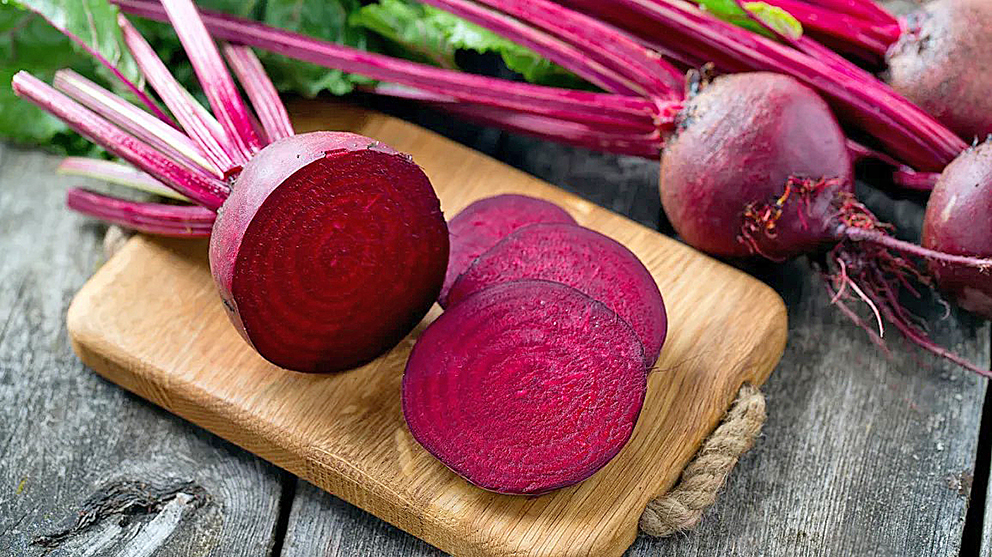Beetroot

.
Paula Sharp, nutritional therapist
Vibrant, sweet, and packed with nutrients, beetroot (beta vulgaris) is one of the Eastern Bay’s vibrant heroes. Known for its deep crimson colour and earthy flavour, it has been valued for centuries, not just as food, but as medicine. In season now, beetroot is a beautiful way to add colour and vitality to winter meals.
History of beetroot
Beetroot belongs to the Amaranthaceaefamily, which also includes spinach, silverbeet, and quinoa. It originated in the Mediterranean region and was first cultivated by the Romans, who prized its roots for food and its leaves for medicinal purposes. Ancient Greeks even used beetroot as an offering to Apollo, the god of the sun.
Initially, only the leaves were eaten - the sweet bulbous root became a staple much later. By the 16th century, beetroot was spreading across Europe as both a food and a natural dye. Today, it’s found around the world and used in soups (like Eastern Europe’s iconic borscht), roasted salads, juices, even desserts and cakes.
Growing and harvesting
Beetroot thrives in our mild winters. Our climate allows for steady growth through the cooler months with beetroot typically sown from autumn through spring.
· Plant in full sun and loose, well-drained soil (heavy clay can lead to misshapen roots)
· Sow seeds directly, as beetroot doesn’t transplant well
· Water consistently to prevent woody or bitter roots
· Quick-growing varieties can be ready in as little as eight weeks. Slower growers mature in 18 weeks.
Pick beets when roots are about the size of a golf to tennis ball – young beetroot is tender and sweet, while larger ones may become tougher. Don’t overlook the leaves – they’re edible and packed with nutrients.
Nutritional benefits
Beetroot is often called a functional food because its benefits go beyond basic nutrition, particularly when it comes to supporting cardiovascular health:
· Folate (vitamin B9) – supports cell repair and heart health
· Vitamin C – boosts immunity, protects arteries, and promotes collagen production in blood vessels
· Potassium – helps regulate blood pressure and fluid balance, lowering strain on the heart
· Iron – supports red blood cell production, vital for oxygen transport
· Magnesium and manganese – aid energy production and support heart rhythm
· Dietary nitrates – naturally occurring compounds that the body converts into nitric oxide, which relaxes and widens blood vessels, improving circulation and lowering blood pressure
· Betalains – the pigments that give beetroot its rich red-purple colour, with antioxidant properties that protect cells and reduce arterial inflammation
· Fibre – helps lower cholesterol and supports a healthy gut microbiome, both key for long-term cardiovascular wellness
Get the most from beetroot
Beetroot can be eaten in many ways, raw and cooked. Raw beetroot retains the highest level of vitamin C and nitrates - grate into salads or juice for its maximum benefits.
Roasting enhances its sweetness and keeps betalain pigments intact.
Steaming or boiling softens the root but will leach some nutrients—cook whole, skin-on, to minimise loss.
Leaves and stems are edible—sauté like spinach or silverbeet for a mineral-rich side.
Pair beetroot with healthy fats (like avocado, nuts, or olive oil) to absorb fat-soluble antioxidants. Combining beetroot with citrus or other vitamin C-rich foods also boosts the absorption of its iron.
Roasted beetroot & feta salad

Roast whole, washed beetroot in coconut oil, sprinkled with thyme, until tender.
Tip: Allow the beetroot to cool and use the edge of a teaspoon to peel the skin. Dice.
Toss with rocket, crumbled feta, toasted walnuts, and a drizzle of balsamic glaze.
Beetroot & carrot soup

Sauté a diced onion with crushed garlic (1 teaspoon or 3 cloves), add 4 peeled and chopped beetroot, 4 large carrots, and 2 bay leaves. Cover with vegetable stock and simmer until tender. Blend until smooth, then season with black pepper and a swirl of yoghurt.